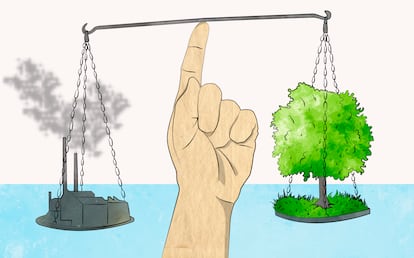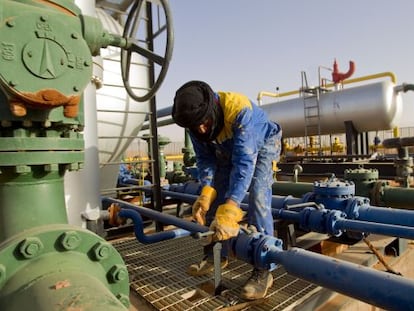The unknowns of the climate transition
The steep rise in global power costs has raised many questions about how to achieve the goal of renewable, clean and cheap energy

The last few weeks have showcased the future of the climate transition. The parabolic increases in global energy prices have revealed the stress points of a process that is no longer a diffuse, medium-term project, but rather something with an imminent impact on our lives, and which by its nature will often present difficult-to-resolve trade-offs. Because the imperative need to increase the production and consumption of renewable energies does not respond to an immediate economic logic, but to the desire to avoid a long-term catastrophe. And it requires actions, among them a premeditated increase in non-renewable energy prices, which, potentially, will conflict with price stability, fiscal discipline and the reduction of inequality and poverty. In 2019, I wrote that climate transition strategies could not ignore the economic impact on citizens, or they would risk losing the popular support necessary to carry them out. Today it is time to warn of the need for all macroeconomic policies to internalize the needs of climate transition policies.
The key word in this dilemma is “transition.” The end point is clear: an energy supply based on renewable, clean and cheap energy, with zero emissions. The problem is how to get there. Because, today, renewables cannot be the core of the energy supply, because there is not enough production and they suffer from intermittency as it is not economically viable to store them on a large scale. The energy mix of the transition requires marginal energies that cover the moments when there is a deficit of renewables. And that marginal energy, mainly due to the nuclear stoppage, today is gas and, in the absence of gas, oil and coal.
If there is a conflict of objectives, what should be the priority: the success of the climate transition, growth or fiscal and monetary rules?
The last few weeks have been the closest thing to a perfect storm, but this does not mean that it won’t happen again. In sum: a shortage of renewables and a shortage of fossil fuels. The economic reopening has generated a sudden increase in global energy demand, due to the sharp increase in demand for durable goods whose production is much more energy-intensive than services – think, for example, of the different energy demands of manufacturing 30 bicycles and giving a spin class for those same 30 people. As a result, global energy consumption is already above pre-Covid levels, although economic activity and gross domestic product (GDP) levels are still lower.
This rapid increase in energy demand has come at a point in time when there was a shortage of eolic energy (the winds have recently been weaker than normal in Europe), increasing the demand for the marginal energy, gas. But Europe’s gas reserves were scarce, triggering gas price increases, which have reached the equivalent, in energy terms, of an oil price of more than $150 (€96) a barrel. This has led gas to be replaced with oil and coal (something that typically happens only in rare moments of very cold winters, but never in autumn). But since the supply of oil and coal is also scarce, partly due to the disincentives arising from the climate transition – who is going to invest in energy that is destined to disappear? – the result has been high prices throughout the energy complex, forcing closures in industries where the profitability of production was negative at those prices. In the absence of supply, the final solution is the destruction of demand.
It has been a serious scare, and it raises many questions. Is it wise to depend so much on an energy – gas – for which there are no adequate reserves, in part because of the opposition to fracking? Europe is highly dependent on gas supplies from North Africa and Russia, which adds a geopolitical risk premium to the price of gas. The Spanish proposal to coordinate and centralize gas purchases at the European level is the logical answer to reduce this risk premium. Is an exclusively marginalist price system reasonable when the marginal energy is gas – and therefore remunerates renewable energies, which are cheaper to produce, with the geopolitical risk premium of gas?
Price liberalization has reduced energy costs, but the current context may require additional alternative mechanisms that not only encourage the production of renewables, but also help to stabilize prices at reasonable levels. In addition, vulnerable consumers need to be protected from excessive price volatility with subsidies and transfers. But should these subsidies be financed with debt, or with a tax on those benefits derived from the gas risk premium? Is it logical to depend so much on gas to ensure energy supply during the transition, or should nuclear energy, which is cheaper and more stable, be part of the solution? Japan, which closed its nuclear power plants after the Fukushima tragedy, is now ready to reopen them to ease the transition. When conditions change, you have to change your mind.
Is it logical to depend so much on gas to ensure energy supply during the transition or should nuclear energy be part of the solution?
These questions, and many more, generate uncertainty that must be clarified as soon as possible, since it limits investment and generates a potential structural deficit of energy. This year’s scare may have lingering effects and keep energy prices high, especially if the winter is cold and gas reserves cannot be replenished for next year. Electricity consumption will structurally increase during the transition, and all countries will be adopting similar policies, amplifying its effects. Unlike oil shocks, this is a cascading effect in slow motion: for example, the increase in the price of gas affects the price of fertilizers, which in turn will affect the price of food in 2022. Production stoppages in China have generated a deficit in the production of magnesium, a fundamental component in the production of the steel needed for the automobile sector, limiting European automobile output.
The climate transition may have multiple macroeconomic effects. For example, “green inflation”: higher prices derived from the imbalance of energy supply and demand and the taxes necessary to discourage the consumption of non-renewable energies. Or “green debt”: the increase in public debt in order to finance public investment that catalyzes private investment in renewables and subsidies, as well as fund the transfers to compensate those most affected by price increases (such as the recent announcement by the French government of a €100 “inflation playout” for lower-income households). This raises more questions: should monetary policy accommodate this “green inflation,” or tighten policy to reduce growth and underlying inflation? Should fiscal rules tolerate the increase in “green debt,” or compensate for it with cuts elsewhere? And if this “green debt” raises long-term interest rates, should monetary policy compensate for it to avoid an economic slowdown?
The bottom line is this: if there is a conflict of objectives, what should be the priority: the success of the climate transition, growth or fiscal and monetary rules?
Tu suscripción se está usando en otro dispositivo
¿Quieres añadir otro usuario a tu suscripción?
Si continúas leyendo en este dispositivo, no se podrá leer en el otro.
FlechaTu suscripción se está usando en otro dispositivo y solo puedes acceder a EL PAÍS desde un dispositivo a la vez.
Si quieres compartir tu cuenta, cambia tu suscripción a la modalidad Premium, así podrás añadir otro usuario. Cada uno accederá con su propia cuenta de email, lo que os permitirá personalizar vuestra experiencia en EL PAÍS.
¿Tienes una suscripción de empresa? Accede aquí para contratar más cuentas.
En el caso de no saber quién está usando tu cuenta, te recomendamos cambiar tu contraseña aquí.
Si decides continuar compartiendo tu cuenta, este mensaje se mostrará en tu dispositivo y en el de la otra persona que está usando tu cuenta de forma indefinida, afectando a tu experiencia de lectura. Puedes consultar aquí los términos y condiciones de la suscripción digital.
More information
Archived In
Últimas noticias
From Andorra to Gibraltar, a black market for Ozempic exploits its success: ‘They’re the most sought-after products in the world’
From safe-haven investment to geostrategic weapon: Who owns the most gold and where are the bars kept?
Todd Green, head of the company that created ‘Candy Crush’: ‘Success for us is that players want to play for years’
Prices soar and Venezuela’s economy struggles under Trump’s pressure: ‘People are living day to day’
Most viewed
- Why we lost the habit of sleeping in two segments and how that changed our sense of time
- Charles Dubouloz, mountaineering star, retires at 36 with a farewell tour inspired by Walter Bonatti
- Venezuela faces its most tense Christmas yet
- CBS in crisis after pulling a report on Trump’s deportations to El Salvador (which later leaked online)
- Bukele clan fumes over investigation exposing their new wealth











































